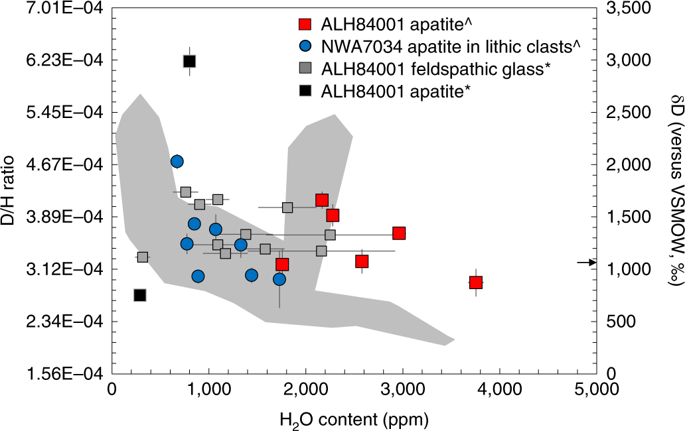Nature Geoscience ( IF 18.3 ) Pub Date : 2020-03-30 , DOI: 10.1038/s41561-020-0552-y Jessica J Barnes 1, 2 , Francis M McCubbin 1 , Alison R Santos 3 , James M D Day 4 , Jeremy W Boyce 1 , Susanne P Schwenzer 5 , Ulrich Ott 6, 7 , Ian A Franchi 5 , Scott Messenger 1, 2, 3, 4, 5, 6, 7, 8, 9 , Mahesh Anand 5, 8 , Carl B Agee 9

|
The abundance and distribution of water within Mars through time plays a fundamental role in constraining its geological evolution and habitability. The isotopic composition of Martian hydrogen provides insights into the interplay between different water reservoirs on Mars. However, D/H (deuterium/hydrogen) ratios of Martian rocks and of the Martian atmosphere span a wide range of values. This has complicated identification of distinct water reservoirs in and on Mars within the confines of existing models that assume an isotopically homogenous mantle. Here we present D/H data collected by secondary ion mass spectrometry for two Martian meteorites. These data indicate that the Martian crust has been characterized by a constant D/H ratio over the last 3.9 billion years. The crust represents a reservoir with a D/H ratio that is intermediate between at least two isotopically distinct primordial water reservoirs within the Martian mantle, sampled by partial melts from geochemically depleted and enriched mantle sources. From mixing calculations, we find that a subset of depleted Martian basalts are consistent with isotopically light hydrogen (low D/H) in their mantle source, whereas enriched shergottites sampled a mantle source containing heavy hydrogen (high D/H). We propose that the Martian mantle is chemically heterogeneous with multiple water reservoirs, indicating poor mixing within the mantle after accretion, differentiation, and its subsequent thermochemical evolution.
中文翻译:

火星内部有多个早期形成的水库。
随着时间的推移,火星中水的丰富和分布在限制其地质演化和可居住性方面起着根本作用。火星氢的同位素组成提供了洞察火星上不同储水层之间相互作用的见解。但是,火星岩石和火星大气的D / H(氘/氢)比值范围很广。在假设同位素同质地幔的现有模型的范围内,这使在火星内和火星上不同的水库的识别变得复杂。在这里,我们介绍通过二次离子质谱法收集的两个火星陨石的D / H数据。这些数据表明,在过去的39亿年中,火星地壳的D / H比保持恒定。地壳代表的D / H比储层介于火星地幔内至少两个同位素不同的原始水储层之间,并通过地球化学贫化和富集地幔源的部分熔体采样。从混合计算中,我们发现一部分贫化的火星玄武岩在其地幔来源中与同位素轻氢(低D / H)相一致,而富矿质的钙锰矿对含有重氢(高D / H)的地幔来源进行了采样。我们认为,火星地幔在化学上是非均质的,具有多个储水层,表明在增生,分化及其随后的热化学演化之后,地幔内部混合不良。从地球化学贫化和富集的地幔来源的部分熔体取样。从混合计算中,我们发现一部分贫化的火星玄武岩在其地幔来源中与同位素轻氢(低D / H)相一致,而富矿质的钙锰矿对含有重氢(高D / H)的地幔来源进行了采样。我们认为,火星地幔在化学上是非均质的,具有多个储水层,表明在吸积,分化及其随后的热化学演化之后,地幔内部混合不良。从地球化学贫化和富集的地幔来源的部分熔体取样。从混合计算中,我们发现一部分贫化的火星玄武岩在其地幔来源中与同位素轻氢(低D / H)相一致,而富矿质的钙锰矿对含有重氢(高D / H)的地幔来源进行了采样。我们认为,火星地幔在化学上是非均质的,具有多个储水层,表明在增生,分化及其随后的热化学演化之后,地幔内部混合不良。


























 京公网安备 11010802027423号
京公网安备 11010802027423号